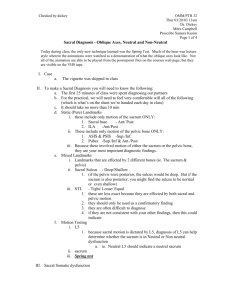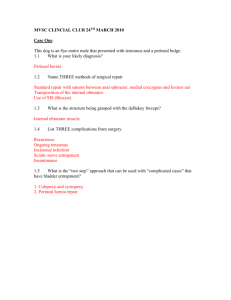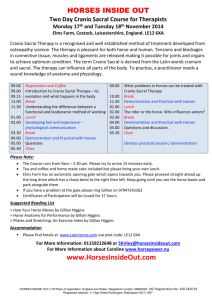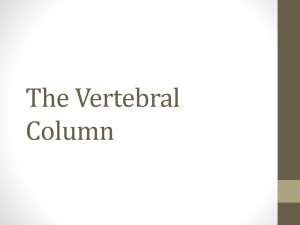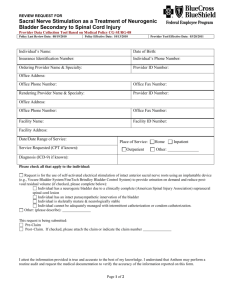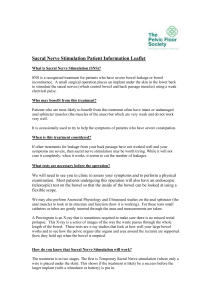Sacral Motion
advertisement
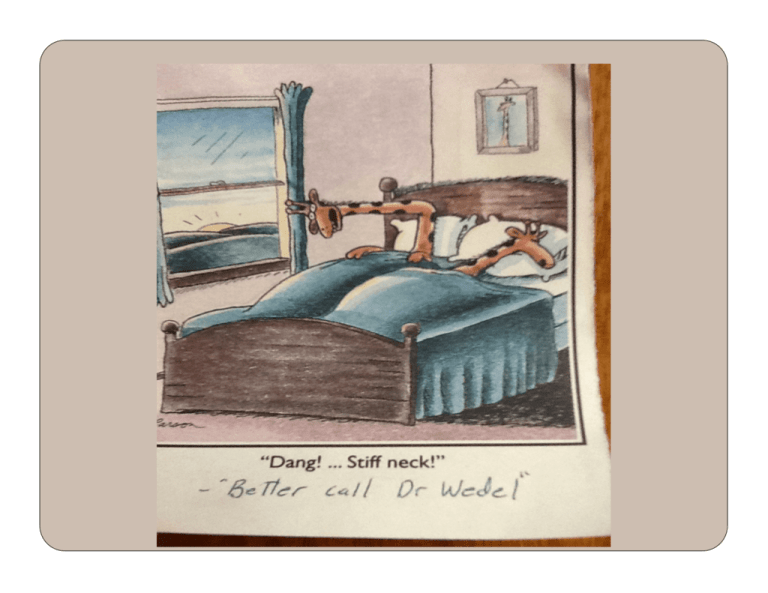
Evaluation and Treatment of Selected Sacral Somatic Dysfunctions Using Direct and HVLA Techniques including Counterstrain and Muscle Energy AND Counterstrain Treatment of the Pelvis and Sacrum F. P. Wedel, D.O. Associate Adjunct Professor in Osteopathic Principles and Practice A.T. Still University School of Osteopathic Medicine in Arizona, and private practice in Family Medicine in Tucson, Arizona Learning Objectives HOURS 1 AND 2 Review the following diagnostic and treatment techniques related to sacral torsion Lumbosacral spring test Sacral palpation Seated flexion test HOURS 3 AND 4 Counterstrain treatments of various low back pathologies Sacral Techniques Covered: 1. Prone, direct, muscle energy, for sacral rotation on both same and opposite axes 2. HVLA treatment for sacral rotation on both same and opposite axes 3. Counterstain treatment of sacral tender points and of sacral torsion Counterstrain Multifidi and Rotatores : UP5L Gluteii – maximus: HFO-SI, HI, P 3L- P 4L ,medius, minimus Piriformis Background and Basis The 4 Osteopathic Tenets (Principles) The body is a unit; the person is a unit of body, mind, and spirit. 2. Structure and function are reciprocally inter-related. 3. The body is capable of selfregulation, self-healing, and health maintenance. 4. Rational treatment is based upon an understanding of these basic principles. 1. Somatic Dysfunction - Defined • “Impaired or altered function of related components of the somatic (body framework) system: • Skeletal, arthrodial, and myofascial structures, • And… • Related vascular, lymphatic, and neural elements” Treatment Options for Somatic Dysfunctions All somatic dysfunctions have a restrictive barrier which are considered “pathologic” This restriction inhibits movement in one direction which causes asymmetry within the joint: The goal of osteopathic treament is to eliminate the restrictive barrier thus restoring symmetry…. Somatic Dysfunction: CHARACTERISTICS “The acronym TART is used to remember the abnormal changes that accompany somatic dysfunction. (Tenderness by itself is not always an indication of somatic dysfunction): • Tissue texture changes • Asymmetry • Restricted range of motion • Tenderness Kimberly Manual, chapter 3 Treatment Methodologies Indirect – movement away from the barrier and more functional than structural Cranial-sacral Counterstrain Balanced ligamentous tension (BLT) Facilitated Positional Release Direct – engagement of the restrictive barrier and movement through it and to it by using the body part as a lever Muscle Energy and MFR HVLA Chapman’s and Lymphatics SACRAL STRUCTURE,LIGAMENTS AND MUSCLES THE SACRUM Means “sacred” because of its density it is the last bone to decay and because it protects the reproductive system Forces on the sacrum Angle of the sacroiliac joint “wedges” the sacrum in an anterior direction Prevents posterior movement Dorsal (posterior) sacroiliac ligaments much stronger than anterior sacroiliac ligaments Purpose: counteract significant pelvic forces pushing apex posteriorly. Major Pelvic Ligaments Iliolumbar from ilia to 5th lumbar vertebrae Sacrospinous Sacrum to spine of the ischium Sacrotuberous Sacrum to ischial tuberosity Sacroiliac Ligament Covers much of the sacroiliac joint, ant & post Iliolumbar ligaments Stabilizes the 5th (4th) Lumbar vertebrae to the ilia Sacrospinous ligament Sacrotuberous ligament Iliolumbar lig Sacrospinous Sacrotuberous Ligament Runs from lower sacral tubercles to ischial Gluteus maximus attachment Tendon of the biceps femoris attachment Connects with fascia of the pelvis from sacrum to ischial tuberosity stabilizes anterior motion tuberosity Both Sacrospinous & Sacrotuberous stabilize to prevent posterior - superior rotation of the sacral apex around a transverse axis Sacroiliac Ligament Sacroiliac actually three ligaments Anterior or ventral sacroiliac from 3rd sacral segment to lateral preauricular sulcus interosseous sacroiliac massive bond between the upper parts of the joint dorsal sacroiliac Partly covers the interosseous, from lateral sacral crest to PSIS and internal iliac crest. Ventral/Anterior Sacroiliac interosseous Posterior sacroiliac Pelvic muscle attachments from above. Attach to Sacrum Erector Spinae Iliocostalis Longissimus Spinalis Multifidus Attach to Innominates Obliques (internal, external, transverse) Quadratus Lumborum Posterior Muscles Erector Spinae (sacrospinalis and iliocostalis) SACRAL ANATOMICAL AXES Transverse axis Superior: the cranial&primary respiratory mechanism creates motion around this axis Middle: sacral base anterior and posterior (FB/BB) occur around this axis Inferior: the innominates rotate around this axis SACRAL MOTION Respiratory motion: inhalation sacral base moves posteriorly (counter-nutates) Respiratory exhalation: sacral base moves anteriorly (nutates) Inherent (craniosacral)motion: ***Craniosacral flexion-base rotates posteriorly (counternutates) Craniosacral extension-base rotates anteriorly (nutates) SACRAL PHYSIOLOGIC AXES Oblique: both left and right oblique axes are named for the superior pole • Sagittal: includes both mid-sagittal and an infinite number of parasagittal axes • Horizontal: functional axis of sacral flexion/extension occur around this axis (analogous to the middle transverse axis above) • (footnote on functional anatomy) Why are the Oblique Axes so significant? They are the Axes of Walking. The walking cycle as it applies to our discussion 1. From a standing (neutral) position, when you take a step forward, your weight is shifted onto one lower extremity. 2. This induces spinal column SB to the weight bearing side, and pins the upper pole of the sacrum on the side of the SB. 3. As the free lower extremity swings forward, it carries the free pole of the sacrum anterior, creating rotation of the sacrum about the Oblique Axis, towards the weight bearing extremity. Ex.: RL on LOA RR on ROA Bottom Line: You form Oblique Axes with every step you take! The other aspect of the walking cycle is the movement of the torso. 1. From a standing (neutral) position, as you step forward, note how your body compensates. What does your torso do? 2. Answer: Rotates towards the moving lower extremity (ie.: away from the weight bearing lower extremity). Bottom Line: Your spine (most notably Lumbar spine) rotates in the opposite direction of the sacrum in a neutral moving situation. TESTS To make a Sacral Diagnosis you will need to know the following: Static (Pure) Landmarks Sacral base ILA ASIS & PSIS Pubes Mixed Landmarks Sacral Sulcus STL - Ant/ Post -Ant/Post -Sup./Inf. -Sup./Inf & Ant./Post Motion Testing Spring test L5 Sacrum - Deep/Shallow - Tight/ Loose/ Equal •Record Positive Right, Positive Left, or Negative Test Spring Test 1. 2. 3. 4. Find sacral base Place heel of hand over Lumbosacral junction Spring in an Anterior motion Results: a. Positive test = If there is NO springing allowed = Non-neutral condition (AKA Backward torsion) b. Negative test = If there is springing allowed = Neutral condition. Prone Landmarks Sacral Base Judge whether the tip of the thumb is more anterior on one side than the tip of the thumb on the other side. Can also bring index fingers over onto sacral base and take measurement on the lateralized side. Record which base is anterior. Sacral Sulcus Depth Palpable groove just medial to PSIS. Space between sacral spines and lateral sacral crest. Place thumbs in inferior border of PSIS. Move ½-1” up and medial to PSIS. Push thumb tips on sacral base. Pads of thumbs are on ilium and tips on sacral base. Measure the depth of each sacral sulcus relative to opposite sulcus? Record even, deep, or shallow, comparing one side to the other. Both sides may be shallow or deep as well. Inferior Lateral Angle 1. Place flat of hand over sacrum near its caudal end and identify the coccyx. 2. Thumbs approximately 1” apart. Place thumbs in gluteal area about 1” caudal and on each side of coccyx. 3. Push thumbs cephalad until pads rest on inferior margin of ILA. Take a reading on the lateralized side: Inferior or superior? Possibly even? 4. Move thumbs approximately 1” cephalad from the inferior margin of the ILAs and place the pads of the thumbs over the posterior surface of the ILAs near the apex of the sacrum. 5. Use moderate equal pressure & judge if one side is more anterior or posterior than the other one or are they equal? Record on the lateralized side. 1. Place thumbs on the inferior margin of ILA. 2. Move thumbs inferiorly and laterally from the ILA bilaterally, palpating for the sacrotuberous ligament. 3. Ligament will be found between the ILA and the ischial tuberosity on each side. 4. Press thumbs anteriorly, superiorly, and 45-50 degrees laterally to check the tension on the sacrotuberous ligaments. 5. Are they equal in tension or is one tighter or looser than the other? Note which side is looser and which is tighter, relative to the other side. Sacrotuberous Ligament L5 Locate L5 transverse processes, bilaterally Place thumbs over L5 transverse processes, bilaterally Note relative positions of L5 transverse processes bilaterally Which is anterior? Which is posterior? What is the preference of motion at L5 for Rotation? Record the Rotation of L5, Right, Left, or No Rotation L5 rotates to the opposite side of sacrum and side bends to same side as the sacral axis motion Motion Tests for Sacral Diagnosis ASIS Compression Test Have the patient lie supine. The patient is then asked to raise his/her bottom up off the table and then set it back down again. Doctor Stands with head and shoulders centered over the patient. Contact the ASIS Stabilize one ASIS while applying pressure at a 45 degree angle to the other ASIS Positive test - restricted movement of the Sacroiliac joint -> rock like motion Negative test - a sense of give or resilience => bounce or spring like motion DIAGNOSIS AND TREATMENT Of SACRAL TORSIONS Sacral Dysfunction Assessment Are ILA’s Symmetric Superior/Inferior? No Yes Physiologic: Oblique Axis: Sacral Torsions Is the Sacral Base Symmetric Anterior /Posterior? Non - physiologic: Unilateral Sacral Shear (Unilateral Sacral Flexion And Extensions) No Yes Sacral Base Posterior Sacral Base Anterior Neutral Sacrum Sacral Margin Posterior Upslipped Innominate FRYETTE’S LAWS Law I: When the spine is in neutral, sidebending to one side will be accompanied by horizontal rotation to the opposite side. In type I somatic dysfunction, this law can be seen when more than one vertebrae are out of alignment and cannot be returned to neutral by flexion or extension. The involved group of vertebrae demonstrates a coupled relationship between side bending and rotation. When the spine is neutral, side bending forces are applied to a group of typical vertebrae and the entire group will rotate toward the opposite side: the side of produced convexity. Extreme type I dysfunction is similar to scoliosis. Law II: When the spine is flexed or extended (non-neutral), sidebending to one side will be accompanied by rotation to the same side. In type II somatic dysfunction of the spine, this law can be seen when only one vertebrae is out of place and becomes much worse on flexion or extension. There will be rotation and sidebending in the same direction when this dysfunction is present Law III: When motion is introduced in one plane it will modify (reduce) motion in the other two planes. Type III sums up the other two laws by stating dysfunction in one plane will negatively affect all other planes of motion Lumbosacral Mechanics and Torsions Example L rotation on LOA Lumbar spine neutral: SL RR (note in all torsions, L5 will rotate opposite of sacrum) N.B. this example is type 1- which go with Forward torsions as type II go with backward torsions Requires normal lordosis Occurs when (R) sacral base rotates anterior (“forward”) and does not rotate back (feels “springy”) left ILA posterior, & inferior (i.e., taking a step forward on r leg) SL RR A Lo P nL OA Sacral Motion In Neutral (type I) mechanics: the sacral base moves Anteriorly and rotates opposite to the rotation of L5 ; Its axis motion is the SAME as the SB side of L5 so : Example: L5 RrSl causes a L on LOA, ( L on L) sacral torsion the R edge is rotated L and anterior while the axis is left so it = to the SB side of L5 Sacral Motion In Non-Neutral (type 2) mechanics, the sacral base rotates backwards. It is still opposite to the L5 rotation side and Its axis is the same as the L5 SB side Example: L5 RlSl causes a R on LOA, the right sacral base moves Posteriorly while its axis side is Left and oblique Sacral Torsion Rules A sacral torsion requires a deep sulcus and a posterior and inferior ILA to be on opposite sides A deep right sulcus must have an posterior and inferior ILA on the Left by the above definition Sacral Sulcus Depth Palpable groove just medial to PSIS. Space between sacral spines and lateral sacral crest. Place thumbs in inferior border of PSIS. Move ½-1” up and medial to PSIS. Push thumb tips on sacral base. Pads of thumbs are on ilium and tips on sacral base. Measure the depth of each sacral sulcus relative to opposite sulcus? Record even, deep, or shallow, comparing one side to the other. Both sides may be shallow or deep as well. o Sacral Torsion Rules Name of lesion: Is for rotation and axis sides: R on R = right rotation on a right axis R on L = right rotation on left axis Sacral Torsion Rules Rotation side = the 1st of the 2 letters: L on L, or L on R, R on R, or R on L The 1st Letter Is also the posterior or backward edge of the sacral base Is the Short leg side Is the side of the posterior/ inferior ILA Sacral Torsion Rules The second letter ( R on R) refers to the Axis side of the sacrum that is in play Is the same as the side bent side of L5 Sacral Torsion Rules Seated flexion test is + on the side of the dysfunctional edge of the sacral base that is rotated either R or L and is either forward or backward The seated flexion test is the hallmark objective exam to determine your torsion diagnosis side and thus what edge to treat Sacral Torsion Rules L5 will be Convex to deep sulcus which = anterior edge Long leg on deep sulcus = anterior edge Forward lesions no + spring ; back ward lesions + spring FORWARD TORSIONS Neutral - Left Oblique Axis Findings Name: L on LOA, RL on LOA, Landmarks – Static: Sacral Base: L posterior Sacral Sulcus: L shallow ILA: L Post/ Inf. STL: L Tight Motion Testing: Spring: - (neg) L5: SLRR Sacral Base L - R + ILA: L +/- R +/- L5: S LRR A+ P↓+/- Left Right Midline Neutral - Right Oblique Axis Findings: Name: R on ROA, RR on ROA, Landmarks – Static: Sacral Base: R posterior Sacral Sulcus: R shallow ILA: R Post/Inf. STL: R tight Motion Testing: Spring: - (neg) L5: SRRL Sacral Base: L+ RILA: L +/- R +/- A+ P↓+/- Left Right Midline Right Forward Torsion RR on ROA Palpatory Experience We can induce these Neutral diagnoses using the mechanics of the sacrum and spine… SBL --> L on LOA A+ P↓+/- Forward Sacral Torsion ME (a right on right sacral torsion) 1. Axis side down; chest on the table 2. Monitor at the lumbo-sacral junction 3. Flex the knees and hips until motion is felt at the lumbosacral junction 4. Support legs/knees with thigh or pillow 5. Apply pressure downward on lower legs/ankles 6. Ask patient to try to raise feet towards the ceiling while you resist 7. Rest 8. Re-engage barrier by repositioning ankles downward 9. Repeat 6, 7, 8 10. Recheck Relative contra-indications-acute sacroiliac sprain, acute sacrum fracture, severe knee arthritis, deep venous thrombosis, or premature labor HVLA FOR ANTERIOR SACRUM Anterior Sacrum Leg Pull – HVLA (SDOFM 118 – 9.6) Associated with forward sacral torsions, eg. L on L 1. 2. 3. 4. 5. 6. 7. Patient supine, physician stands at foot of table Grasp patient’s right ankle just Above malleoli with both hands. Instruct patient to relax all muscles in low back and leg Internally rotate leg to accumulate forces at Right Sacroiliac Joint (Gaps the SI joint) Keep leg and thigh at level of table Apply quick pull on leg, carrying right innominate anteriorly to meet sacrum (correcting the somatic dysfunction) Contraindicated in knee instability Recheck Posterior Sacrum Leg Pull – HVLA (SDOFM 119 – 9.7) Eg. Right Posterior Sacrum = Sacrum rotated Right on the Left Oblique Axis. 1. 2. 3. 4. 5. 6. 7. Patient supine, physician stands at foot of table Grasp patient’s right ankle just Above malleoli with both hands. Instruct patient to relax all muscles in low back and leg Internally rotate leg to accumulate forces at Right Sacroiliac Joint (Gaps the SI joint) Keep the knee extended and flex hip until tension is felt on hamstrings Apply final corrective force (quick pull on leg), carrying right innominate posteriorly to meet sacrum. Recheck Contraindicated in knee instability POSTERIOR SACRAL TORSIONS Non-Neutral: Left Oblique Axis Findings (right on left sacral torsion) Name: R on LOA, RR on LOA, Landmarks – Static: Sacral Base: L Anterior Sacral Sulcus: L Deep ILA: L Ant/ Sup STL: L Loose Motion Testing: Spring: + (positive) L5: RLSL Sacral Base L - R +/ILA: L+ R +/- S L5: R L L P+/- A↑ ↑+ Left Right Midline Non-Neutral: Right Oblique Axis Findings (left on right sacral torsion) Name: L on ROA, RL on ROA, Landmarks: Sacral Base: Sacral Sulcus: ILA: STL: Motion Testing: Spring: L5: Sacral Base: ILA: P+/R Anterior R Deep R Ant./Sup. R loose L +/L +/- + RRSR RR+ A↑ ↑+ Left Right Midline Right Backward Torsion RL on ROA Palpatory Experience We can induce these Non-Neutral diagnoses using the mechanics of the sacrum and spine... SBL-> R on LOA P+/- A↑ ↑+ Backward Sacral Torsion Muscle Energy ( left on right torsion) 1. Have the patient lie on the table axis side down 2. Monitor at the lumbosacral junction 3. Rotate the upper torso posteriorly until motion is felt at the lumbosacral junction 4. Hold the position of torso rotation 5. Flex the top leg until motion is felt at the lumbosacral junction; bend the knee and adduct the hip until motion is felt 6. Ask the patient to push their knee up towards the ceiling while you resist 7. Rest 8. Re-engage the barrier by adducting the knee/hip until motion is felt at the lumbosacral junction 9. Repeat 6, 7, 8 10. Recheck Relative contraindications: acute sacroiliac sprain, acute sacrum fracture, severe hip arthritis, deep venous thrombosis, or premature labor HVLA FOR POSTERIOR SACRUM Anterior Sacrum Leg Pull – HVLA (SDOFM 118 – 9.6) Associated with forward sacral torsions, eg. L on L 1. 2. 3. 4. 5. 6. 7. Patient supine, physician stands at foot of table Grasp patient’s right ankle just Above malleoli with both hands. Instruct patient to relax all muscles in low back and leg Internally rotate leg to accumulate forces at Right Sacroiliac Joint (Gaps the SI joint) Keep leg and thigh at level of table Apply quick pull on leg, carrying right innominate anteriorly to meet sacrum (correcting the somatic dysfunction) Contraindicated in knee instability Recheck Posterior Sacrum Leg Pull – HVLA (SDOFM 119 – 9.7) Eg. Right Posterior Sacrum = Sacrum rotated Right on the Left Oblique Axis. 1. 2. 3. 4. 5. 6. 7. Patient supine, physician stands at foot of table Grasp patient’s right ankle just Above malleoli with both hands. Instruct patient to relax all muscles in low back and leg Internally rotate leg to accumulate forces at Right Sacroiliac Joint (Gaps the SI joint) Keep the knee extended and flex hip until tension is felt on hamstrings Apply final corrective force (quick pull on leg), carrying right innominate posteriorly to meet sacrum. Recheck Contraindicated in knee instability ORIGINAL COUNTERSTRAIN SACRAL TENDERPOINTS Sacrum • The tender points are probably in the area of attachment of the • multifidis, spinalis, longissimus, iliocostalis muscles & overlying fascia COUNTERSTRAIN FOR SACRAL TORSION (not the same as counterstrain for the sacrum) Paper published by Ramirez in JAOA Vol 91 No 3 March 1991 described the following: Both anterior and backward sacral torsions were treated by: 1)noting the side of the tender sacral foramina – (will be the same as the axis side of the torsion) 2)sitting on opposite side of the tender points and abducting prone patient’s leg 30 degrees off table and flexing hip to rest on your thigh 3) pushing anteriorly on ipsilateral PSIS with operator’s forearm for 90 seconds SOURCES AND RESOURCES KIMBERLY MANUAL-2006 EDITION POCKET MANUAL OF OMT-2ND EDITION PRINCIPLES OF MANUAL MEDICINE-GREENMAN OMT REVIEW-SAVARESE-3RD EDITION LECTURES FROM OMM FACULTY – A.T.STILL UNIVERSITY-PHOENIX AZ- WITH PERMISSION LECTURES FROM DR.HARMON MYERS JAOA Vol 91 No 3 March 1991 THANK YOU SACRAL SHEARS ILAs are inferior and posterior on same side of deep sulcus – which distinguishes this from a torsion Produced when the sacrum shifts forward within the sacroiliac joint. Two Types: Unilateral Sacral Flexion Unilateral Sacral Extension Sx: Chronic low back pain. Naming the Shear The shear is named for the side of the inferior ILA.. The sulcus is deep on same side- (which distinguishes this from a torsion) The seated flexion positive side will tell you how to interpret whether it is a unilateral flexion or extension, i.e.,sulcus deep and ILA on R with R seated flexion + = R unilateral Flexion; L unilateral extension if seated is + L with the same findings of: deep sulcus R and ILA post/inf R Springing Respiratory Force Left Unilateral Sacral Flexion A Monitor at PSIS Abduct and internally rotate LE until motion is felt. Maintain that position by leaning of the patient’s femur/leg Springing Respiratory Force Left Unilateral Sacral Flexion B 1. Contact left ILA and apply superior and anterior pressure 2. Have the patient take a deep breathe in and hold (encourages sacral base to move posteriorly) 3. Spring anteriorly and superiorly while patient is holding breath 4. Exhale while physician maintains gain in position 5. Repeat steps 2, 3, 4 6. Recheck SOURCES AND RESOURCES KIMBERLY MANUAL-2006 EDITION POCKET MANUAL OF OMT-2ND EDITION PRINCIPLES OF MANUAL MEDICINE-GREENMAN OMT REVIEW-SAVARESE-3RD EDITION LECTURES FROM OMM FACULTY – A.T.STILL UNIVERSITY-PHOENIX AZ- WITH PERMISSION LECTURES FROM DR.HARMON MYERS THANK YOU Upslip innominate(pubic shear) UPSLIP INNOMINATE Diagnose: L iliac crest superior L ischial tuberosity is superior L medial malleolus is superior L base is anterior so sulcus may be Deep L ILA may be posterior but ILAs are = Seated flexion + L ASIS compression is + L Motion restricted at L base and ILA Tender at S/I joint Upslip treatment Superior Iliac/Pubic Shear Place pressure pad caudad to ipsilateral ILA to help restrict caudad motion of the sacrum Abduct and internally rotate to gap the ipsilateral SI joint Have the patient take a deep breath and hold (encourages sacral base to move posteriorly) Tug along the long axis of the lower extremity Release Recheck Muscle Energy Superior Pubic Shear 1.Patient supine with dysfunctional side towards the edge of the table 2.Monitor opposite ASIS 3.Extend hip until motion is felt at the monitoring hand 4.Ask the patient to pull knee up while you resist 5.Relax 6.Re-engage extension 7.Repeat 4, 5, 6 8.Recheck Muscle Energy Inferior Pubic Shear Posterior Iliac rotation carries pubic ramus superiorly 1. Monitor ipsilateral ASIS 2. Flex and abduct the hip 3. Contact ischial tuberosity 4. Posteriorly rotate the hip with pressure on the ASIS, ischial tuberosity, and knee 5. Have the patient attempt to straighten the leg while you resist 6. Relax 7. Re-engage rotation 8. Repeat 5, 6, 7 9. Recheck Sacral Somatic Dysfunction (AKA Sacroiliac Dysfunction) Physiologic: Dysfunction that occurs around a Physiologic Axis 1. Vertical 2. Transverse 3. Oblique: Neutral and Non-Neutral Non - physiologic: Dysfunction that does not occur around an axis. Usually caused by trauma. 1. Upslipped Innominate 2. Unilateral Sacral Shear (Unilateral Sacral Flexion) Piriformis Movement The only Vertical Axis Diagnosis is… Name: Sacral Margin Posterior For Left Sacral Margin Posterior: Landmarks: Sacral Base: L Posterior Sacral Sulcus: L Shallow ILA: L Posterior STL: L Tight Motion: Sacral Base: L– ILA: L– P– Shallow P- Sacral Margin Posterior cont... For right sacral margin posterior: Landmarks: Sacral Base: R posterior Sacral Sulcus: R shallow ILA: R posterior STL: R tight Motion: Sacral Base: R ILA: R - P– Shallow P– Right Sacral Margin Posterior Sacral Margin Posterior: (ILA’s are level superiorly/inferiorly) On the posterior side: Entire sacral margin is posterior Base is posterior ILA is posterior Sulcus is shallow Sacrotuberous ligament is tight Anterior springing at the superior and inferior poles is restricted Sacral Margin Posterior can occur on either side of a Vertical axis, but it is always named for the posterior side! P– Shallow P– Left Sacral Margin Posterior P– Shallow P– Right Sacral Margin Posterior HVLA Posterior Sacral Margin Stand on side opposite the posterior margin Sidebend the patient away from you Stabilize the ASIS on the posterior margin side Have patient clasp hands behind neck Place cephalad arm through the space created by the patient’s arm and rest on sternum Rotate the patient towards you (spine and sacrum) until tension is felt at the stabilizing ASIS HVLA thrust is applied posteriorly through the ASIS Recheck SACRAL DIAGNOSIS Diagnosis Seated Flexion Test Sacral Base/Sulci ILA levelness L5 Rot Spring Test LS Flexion Asymmtry Left on left Right Anterior right Posterior left Right Negative Decreased Left on Right Right on right Left Left Anterior right Anterior left Posterior left Posterior Right Right Left Positive Negative Increased Decreased Right on Left Right Anterior Left Posterior Right Left Positive Increased Left Unilat Flex Left Anterior Left Posterior Left - Negative Decreased Left Unilat Ext Left Anterior Right Posterior Right - Positive Increased Right Unilat Flex Right Unilat Ext Right Anterior Right Posterior right - Negative Decreased Right Anterior Right Posterior left - Positive Increased Ant Margin - R Right Anterior Right Anterior Right Left Negative Decreased Ant Margin – L Left Anterior Left Anterior Left Right Negative Decreased Post Margin – R Post Margin – L Right Shallow R Posterior Right Right Positive Increased Left Shallow L Posterior Left Left Positive Increased Bilateral Flexion N/A Deep Bilateral Shallow Bilateral - Negative N/A Bilateral Extnsn N/A Shallow Bilateral Deep Bilateral - Positive N/A Multiple axes of motion: Transverse (3) Superior S1 Middle S2 Inferior S3 Vertical (sagittal) A/P Oblique (2) Left Right Sacral Axes Supine, indirect, respiratory cooperation, for bilateral flexion - 4521.11C Sacral Base Anterior (several terms describing the same motion) Sagittal Plane-Middle Transverse Axis Bilateral Sacral Flexion Kimberly manual 2006, p. 193 (4521.11A-E) (different than the sacral “flexion & extension” in the Magoun-type cranial field model) Nutation From the Latin “nutare”- to nod Nutated Sacrum Anterior Nutation Sacral Base Anterior (Bilateral Sacral Flexion) Inferolateral angles level Sulci deep bilaterally Sacral base anterior bilaterally Sacrotuberous ligaments tight bilaterally Base anterior springing present Apex anterior springing restricted Look for “discontinuity” at the lumbo-sacral junction Sacral Base Anterior: Base bilat. anterior on the middle transverse axis Name: Sacral Base Anterior, Or bilat. Sacral Flexion, Or Nutation Landmarks: Sacral Base: Sacral Sulcus: ILA: STL: Motion: Sacral Base: ILA: Bilat. Anterior Bilat. Deep Bilat. Posterior Bilat. Tight A+ Deep A+ Deep Bilat. + Bilat. – P- P- Muscle Energy Bilateral Sacral Flexion Physician contacts paraspinal muscles lateral to L5 Flex patient until motion is localized at lumbosacral junction Have patient attempt to gently straighten legs Resist Rest Re-engage flexion and repeat Sacral Base Posterior Sagittal Plane-Middle Transverse Axis Bilateral Sacral Extension Kimberly manual 2006, p. 197 (4522.11A-C) (different than sacral “flexion & extension” in the Magoun-type cranial field model) Counter Nutation Posterior Nutation Sacral Base Posterior (Bilateral Sacral Extension) Inferolateral angles level Sulci shallow bilaterally Sacral base posterior bilaterally Sacrotuberous ligaments “relaxed” bilaterally Apex anterior springing present Base anterior springing restricted Sacral Base Posterior Base bilat. posterior on the middle transverse axis Name: Sacral Base Posterior, Bilat. sacral extension ,or Counternutation Landmarks: Sacral Base: Sacral Sulcus: ILA: STL: Motion: Sacral Base: ILA: Bilat. Posterior Bilat. Shallow Bilat. Anterior Bilat. Loose PShallow A+ Bilat. – Bilat. + PShallow A+ SACRAL MECHANICS Physiologic diagnoses of the sacrum occur in neutral and non-neutral mechanics: Neutral Mechanics a.k.a. Left rotation on a Left Oblique Axis or or Forward Torsion Sacral Nutation (all three are equivalent terms!!) In neutral mechanics, the sacrum rotates in the same direction as the oblique axis (left rotation on a left oblique axis) Non-neutral Mechanics a.k.a. or or Right rotation on a Left Oblique Axis Backward Torsion Sacral Counter-Nutation (all three are equivalent terms!!) In non-neutral mechanics, the sacrum rotates in the opposite direction of the oblique axis (right rotation on a left oblique axis) FRYETTE’S LAWS Law I: When the spine is in neutral, sidebending to one side will be accompanied by horizontal rotation to the opposite side. In type I somatic dysfunction this law can be seen when more than one vertebrae are out of alignment and cannot be returned to neutral by flexion or extension. The involved group of vertebrae demonstrates a coupled relationship between side bending and rotation. When the spine is neutral, side bending forces are applied to a group of typical vertebrae and the entire group will rotate toward the opposite side: the side of produced convexity [2] Extreme type I dysfunction is similar to scoliosis. Law II: When the spine is flexed or extended (non-neutral), sidebending to one side will be accompanied by rotation to the same side. In type II somatic dysfunction of the spine, this law can be seen when only one vertebrae is out of place and becomes much worse on flexion or extension. There will be rotation and sidebending in the same direction when this dysfunction is present[3]. Law III: When motion is introduced in one plane it will modify (reduce) motion in the other two planes.[4] Type III sums up the other two laws by stating dysfunction in one plane will negatively affect all other planes of motion

